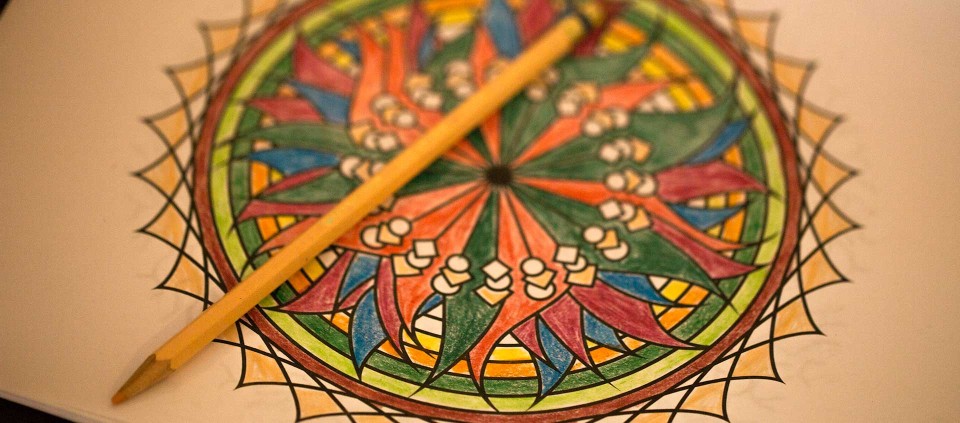The Calming Energy of Color

May 27, 2020
As the days blend together, I try to balance obsessive news consumption with simple pleasures. Inspired by Lauren Gernady’s article “How to Isolate According to Your Dosha,” I dig out an unopened coloring book called Calming Swirls (“stress-relieving designs to color”). I color in rainbow order, or Roy G. Biv, as I learned in school: red, orange, yellow, green, blue, indigo, violet. It’s soothing to see the colors grouped in this way. I’m creating symmetry at a time when little feels balanced or orderly.
I’m a child of the 1970s, a time when rainbow fashion was ubiquitous, from T-shirts to suspenders to lunchboxes. I collected rainbow stickers and watched the crystal sun catcher in my window, pleased by the spectrum of light on my walls. I looked for every opportunity to create rainbow order: with matchbox cars, socks, my parents’ collection of coffee mugs. I still organize my closet according to Roy G. Biv, and hang wet laundry in rainbow order, too. It makes this mundane task a little fancy.
As a tween, I arranged school outfits in my mind as I drifted off to sleep. Green T-shirt with a yellow sweatshirt? (Hopeful, as in daffodils?) Blue socks with white pants? (Steady and buoyant, as in sailboats?) I couldn’t articulate this at the time, but I knew that colors could reflect my longings and moods.
“To be drawn to certain colors means that the color invokes an emotional or psychological response,” says Koya Webb, founder of Get Loved Up, a community that promotes connection through chakra-balancing workshops. “When you’re drawn to a color, you end up seeking it out in your daily life, whether your choice of clothing, the paint color in your house, even your toothbrush.”
Says Koya, “Each of the seven chakras has its own color, controls a specific bodily function, and influences certain emotions. Therefore, each has its own signal for being out of alignment. For instance, when the fifth chakra (blue), vishuddha, located in the throat, is overactive, you may be an incessant talker. Alternatively, if your throat chakra is underactive, you may find it difficult to express your true feelings or have a fear of speaking. On the other hand, when your throat chakra is balanced and in alignment, you have good, clear communication and are able to express yourself authentically.”
As I struggle to focus and put words together these days, I’m drawn to blue. I use my favorite blue pen, intending to make my communication clear.
In kindergarten, I fought with my friend over the midnight blue Crayola crayon—it was the perfect articulation of nighttime. I must have won the argument, because I remember nibbling on the blue, wanting the color to be part of me. I liked to blend my crayon colors too. I found that yellow, scribbled over blue, made a greenish shade.
This is a simplified version of color theory, developed by Leonardo da Vinci in 1490 and expanded upon by Isaac Newton in the 18th century. Visual artists continue to create their color palettes in this way: mix the primary colors (red, yellow, blue) to create secondary colors (orange, green, purple) and tertiary colors (red-purple, red-orange, blue-green, blue-purple, yellow-green, and yellow-orange).
Humans can perceive over 2.8 million different colors.That’s a lot of sub-tertiary mixtures. And a lot of shades to interpret.
Kripalu presenter Dougall Fraser, author of Your Life in Color, says color is intentional, a reminder of how he wants to be. He wears a purple shirt when he has a speaking engagement, for instance, which reminds him he’s capable and strong, a leader. “I look down and see purple and remember.”
“My parents used to say I would talk about seeing colors above my crib as a toddler,” writes Dougall in his book.“I don’t remember this, but I do remember announcing at the age of five that I had a friend who was a ball of pink light.” He’s been able to see auras around people as they speak ever since.
“I’ve been told that I exhibit signs of synesthesia, which is when one sense (like sight) leads to an automatic, involuntary stimulation of a second sense (like sound or taste),” Dougall writes. “Essentially, synesthesia is when two senses overlap in unusual ways. In my case, hearing the sound of your voice results in my seeing color around you. I connect a third sense, which is the feeling or energy of each color.”
Just as individual colors can embody intentions and energy, so does the rainbow as a whole. In numerous spiritual traditions, the rainbow serves as a message between humans and deities. (See Noah’s Ark.) It’s a symbol of social change, as in the flag adopted by the LGBTQ+ community in the 1970s. In song, it’s a reminder to reach for our passions, as in “Somewhere Over the Rainbow.” It’s a way to remember our bonds with others, even as we’re far apart, as in “The Rainbow Connection.”
I think of this song (and of Kermit the Frog playing his banjo), as children place homemade rainbows in windows, a unifying gesture from isolated households. It’s a way to say, “I see you” to a neighbor passing by on a daily walk. My husband encourages me to put my rainbow of calming swirls in our window. We have few passers-by, except for the raccoons and chipmunks, but it feels right to do so.
Then I hang out our laundry, red to purple, another simple pleasure to sustain me at this time. The colors remind me: I have much to be grateful for.
Lara Tupper, MFA, is the author of two novels, Off Island and A Thousand and One Nights, and Amphibians, a linked short story collection forthcoming in 2021.
Full Bio and Programs